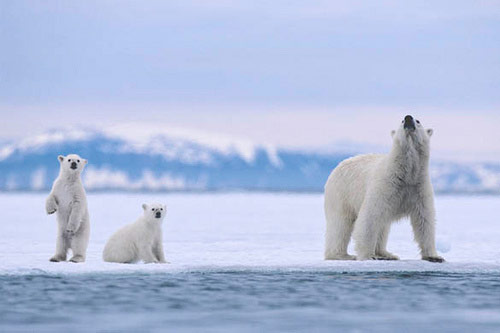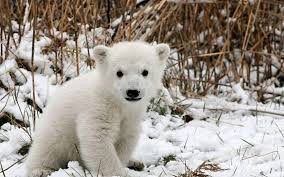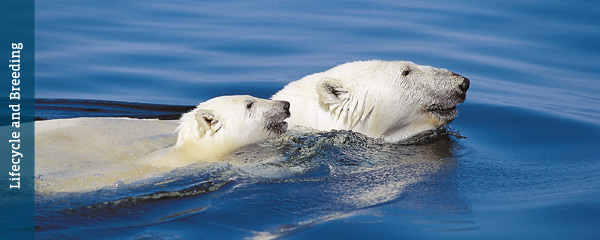It’s one thing to live successfully in the Arctic, keeping warm and finding food. Raising cubs that begin their fragile lives weighing less than one pound requires an incredible extra amount of nurturing care, attention, and energy.

The story begins out on the sea ice in spring, usually late March. Food is relatively plentiful and the bears have surplus energy with which to pursue romantic interest. Here’s the first hurdle: polar bears are solitary animals ranging vast, empty tracts of snow and ice. How on earth are they supposed to locate a potential mate? We don’t really know for sure, but the leading theory is that females can leave a scent trail using special glands in their feet. When a male polar bear crosses the tracks of a female in mating season he will turn to follow in her wake, following her tracks for 100 kilometres or more.
Once the two bears have found each other the male becomes quite bossy. He’ll herd the female into an area that he likes, and do everything he can to prevent her leaving or other males from paying attention to her. ‘Jealous’ probably isn’t a strong enough word to describe the possessive behaviour of a male polar bear with his heart set on procreation.
It is thought that the attention of the male during this time, which can last for several days to a few weeks, is what prompts the female to ovulate and become fertile – effectively ‘arousing’ her to readiness for mating.
The two bears will mate several times once the female has become receptive, and provided the male successfully fends off all challengers. Afterwards, the happy couple part ways, and the male’s role in the reproductive story is at its end.
The female will continue alone over the sea ice, feeding and fattening up in preparation for entering her maternity den, gaining up to 440 pounds and sometimes more than doubling her body weight. She needs to be in fantastic condition before the summer ‘hungry season’ as her pregnancy will develop, she’ll give birth, and nurse her cubs before the next seal season.
She does have a safety net though. Polar bears mate in spring, but pregnancy and the gestation period doesn’t start until the female enters her maternity den. How is this possible‽ It’s called ‘delayed implantation’. It means that after mating the female has a fertilized egg, called a blastocyst, that doesn’t develop further until it is implanted into the womb, which happens when the female is ready. If for some reason she is not in great shape come fall, then her pregnancy won’t begin. She’ll simply reabsorb the blastocyst and try again next year. This is pretty important when you consider that the polar bear female must be able to sustain herself and her cubs for several months without eating.
Sows seek out maternity dens in the fall, usually October; most are located on land where snow accumulates, with some others denning in the permafrost or on the sea ice. The majority of dens are within 16 kilometres of the coast, but they have been found as far inland as 100 kilometres. A maternity den will consist of an entrance tunnel, an air hole, a main chamber, the cubs’ chamber, and sometimes a lower chamber.
Once the female enters the den and has begun her true pregnancy, she’ll have a gestation period of around four months. During this time she will enter a state similar to hibernation. Her heartbeat will slow from 46bpm to 27bpm, but her body temperature doesn’t rise, as is normal with other hibernating species.
The mother will give birth to 1-4 blind, light brown, 1 pound cubs between November and January. The family stays in the den as the cubs nurse to 22-33 pounds, usually until February to April, while the mother continues to fast. After emerging from the den, the family will spend some time outside, but still in the vicinity of the den; the cubs playing and learning to walk, the mother grazing on vegetation. In about two weeks they will make their way to the sea ice so the mother can catch seal to break her fast, which may have lasted up to eight months.

Cubs will stay with their mother until she abandons or chases them away when they are two and a half; generally when she is ready to breed again. Unusually, on the western coast of Hudson’s Bay cubs may be weaned as early as one and a half years old. Once alone without a mother, siblings sometimes stay together and share food for a period of weeks to months.
Female polar bears reach sexual maturity at age four (age five in the Beaufort Sea region), and their reproductive success peaks in their mid-teens. Polar bears have one of the slowest reproductive rates of any animal; a female will typically have only five litters in her lifetime. Males reach maturity at age six, but competition for female mates is so high that many males will not mate until age ten.
Polar bears are considered long-lived animals; they live to be an average of 15-18 years old in the wild. Some bears have been tagged in their early 30’s, with the highest recorded age being 32. In captivity, some bears reach their mid-to-late 30’s; a female bear, born wild in Russia and shipped to Canada at age 1 after being orphaned, lived to be 42 (euthanized due to multiple organ failure).







